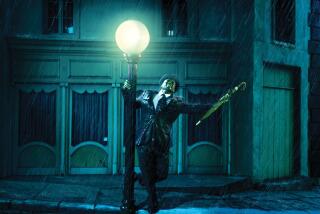What You See Isn’t Always What You Get
- Share via
Making a photograph perfect is next to impossible. But when the commercial advertising market demands it, in steps Aris Kyriazis, owner of Lighting Writing Productions in Costa Mesa.
Either by retouching or recomposing, Kyriazis performs his magic after the press of the shutter and after the film has been developed.
Most of his work comes from art directors who change their minds and need a new background, or perhaps from a photographer whose shot for a car ad was ruined by droplets of water on the car’s mirrored finish.
It’s simply cheaper to have Kyriazis step in instead of reshooting the entire project.
“We do technical photography, removing unwanted highlights from a car photographed on location, problems with shadows which are very deep, or if the background has to be replaced with something else,” he said.
Kyriazis takes the original photo, makes a duplicate and retouches it. Most of the time the duplicate is blown up to an 8-by-10 transparency to make it easier to work on. Then with a brush and dyes, he goes in and corrects the problems.
Three colors are used: yellow, magenta and cyan. By mixing those colors, he creates whatever hue or density is needed to correct the problems.
The commercial work is very expensive because it is time-consuming. The price can range from $500 to $1,000 for retouching or changing a background.
“The average person doesn’t need this service,” said Kyriazis. “We strongly recommend you take a photograph which is perfect to begin with so you don’t need any correction. That’s the best way to do it.”
Kyriazis was born and reared in Greece and immigrated to Canada in 1967. He then moved to New York to study photography. Later, he opened his own studio on 28th Street in Manhattan. “I was kind of technically minded, so I ended up in this business,” he said. He shot stock photographs and worked as a technical representative until he opened up Light Writing in Costa Mesa in 1987.
Kyriazis doesn’t mind working behind the scenes, where his work goes unnoticed by the average viewer. “It doesn’t bother me,” he said. “The professionals, the art directors, the creative directors do notice.”
His artwork can be found on ads for car manufacturers, medical products and clothing.
“Usually, blue jeans come very wrinkled or don’t fit the model very well,” he said. “We have to make them fit and take the wrinkles out. When you photograph new blue jeans, they usually come out almost black with no details,” Kyriazis said. “We have to bring the detail out and change the color. We can go over and reconstruct the entire pants.”
One of his most difficult challenges is combining several photographs into one image. A client might want an exotic background behind the cars, but economics and time don’t allow for it.
Manipulating photographic images can be accomplished through high-tech computer scanners. Kyriazis says the problem with this electronic method is that the client does not end up with a transparency that is reusable for different sizes. Also, electronic imaging can be very expensive. He says electronic darkroom retouching can cost up to $500 an hour.
The Photography column, which runs Saturdays in Orange County Life, is intended to help both the serious amateur and weekend shooter. Questions and ideas are encouraged. Write to: Robert Lachman, Chief Photographer, The Times, 1375 Sunflower Ave., Costa Mesa, Calif. 92626.
More to Read
The biggest entertainment stories
Get our big stories about Hollywood, film, television, music, arts, culture and more right in your inbox as soon as they publish.
You may occasionally receive promotional content from the Los Angeles Times.










